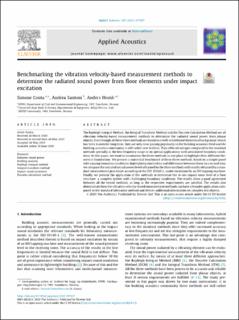Benchmarking the vibration velocity-based measurement methods to determine the radiated sound power from floor elements under impact excitation
Peer reviewed, Journal article
Published version
Permanent lenke
https://hdl.handle.net/11250/2673741Utgivelsesdato
2020Metadata
Vis full innførselSamlinger
- Publikasjoner fra CRIStin - SINTEF AS [5801]
- SINTEF Community [2247]
Sammendrag
The Rayleigh Integral Method, the Integral Transform Method and the Discrete Calculation Method are all vibration velocity-based measurement methods to determine the radiated sound power from planar objects. Even though all these three methods are based on a well-established theoretical background, which has been known for long time, they are only now gaining popularity in the building acoustics field and the building acoustics community is still rather new to them. They offer advantages compared to the standard methods specially in the low frequency range or on special applications with articulated boundary conditions. In this paper, we want to summarize the three methods in one place to highlight their different theoretical foundations. We present a numerical benchmark of these three methods, based on a simple panel with varying boundary conditions, highlighting similarities and differences between them. In a second step, we compare the radiated sound power levels obtained by the three methods with results obtained by a standard measurement procedure according to the ISO 10140-3, under excitation by an ISO tapping machine. Finally, we present the application of the methods to determine the in-situ impact noise level of a floor structure: a complex system with challenging boundary conditions. The results show a good agreement between all the tested methods, as long as the respective requirements are satisfied. The results also demonstrate how the vibration velocity-based measurement methods can have a broader application compared to the standard laboratory method and deliver additional information on complex test objects.

